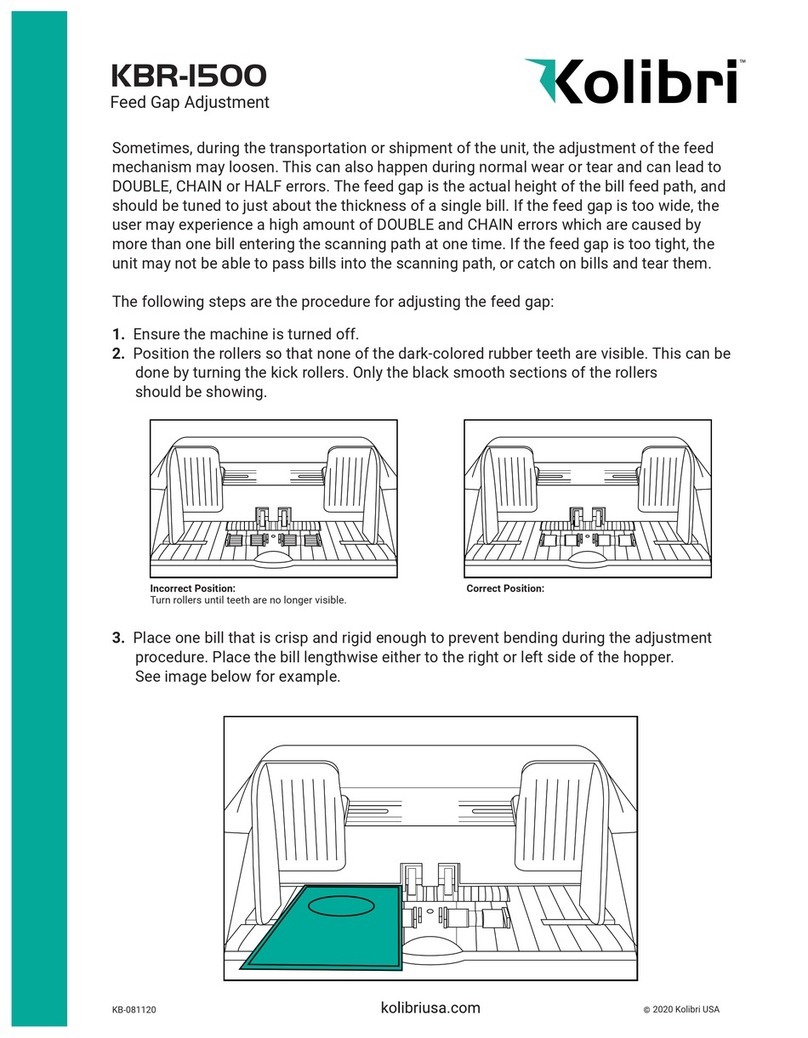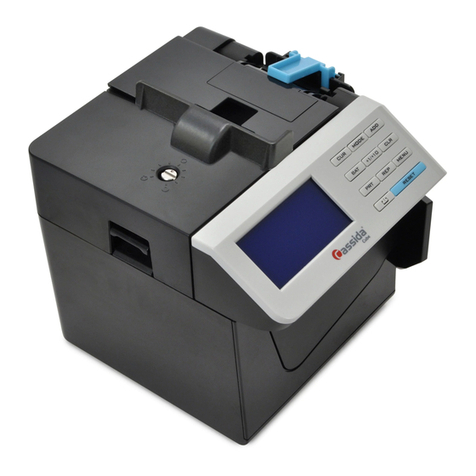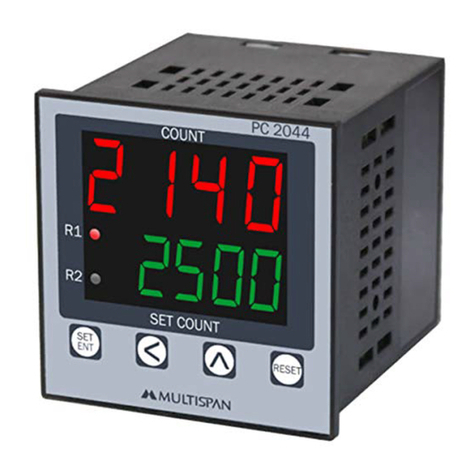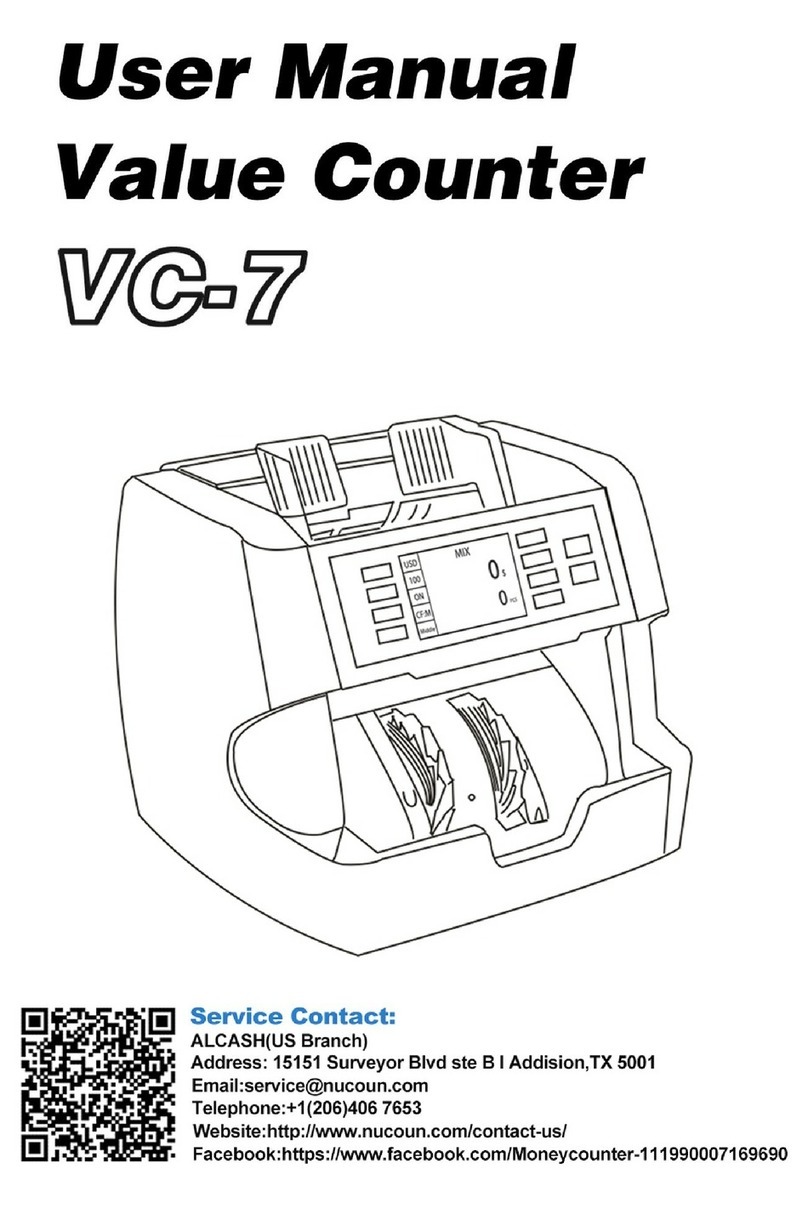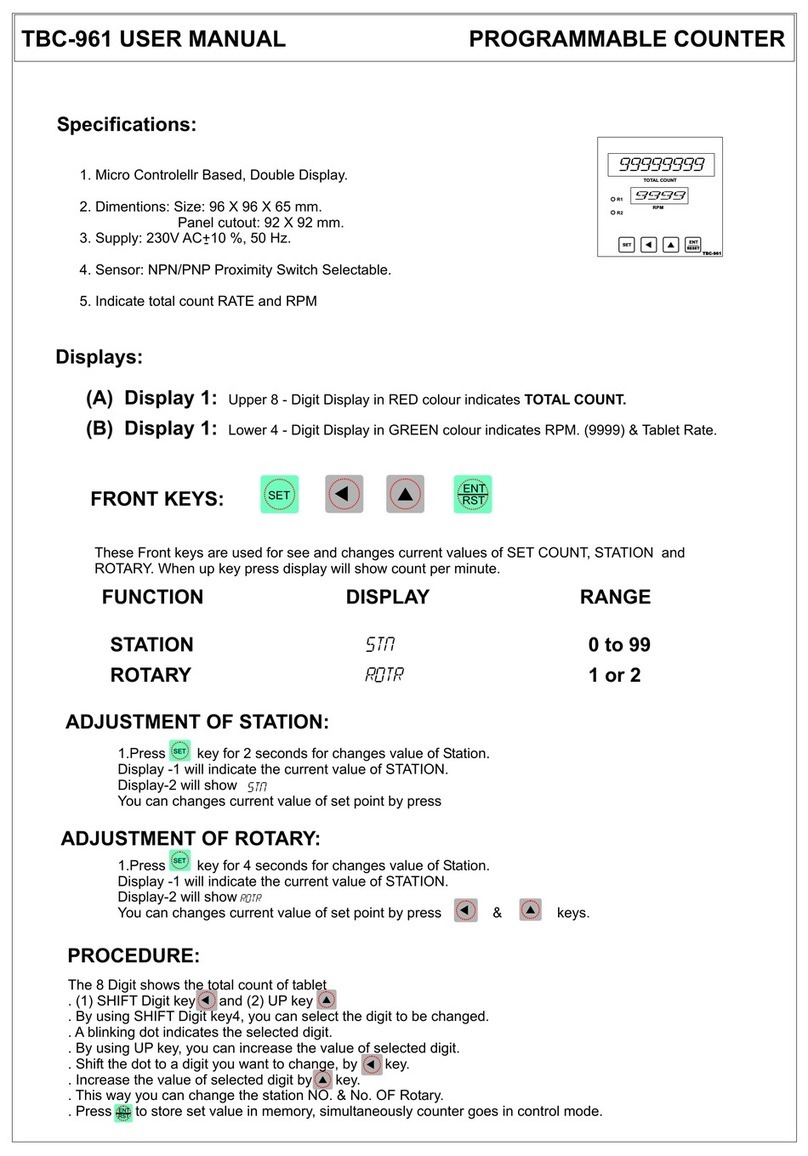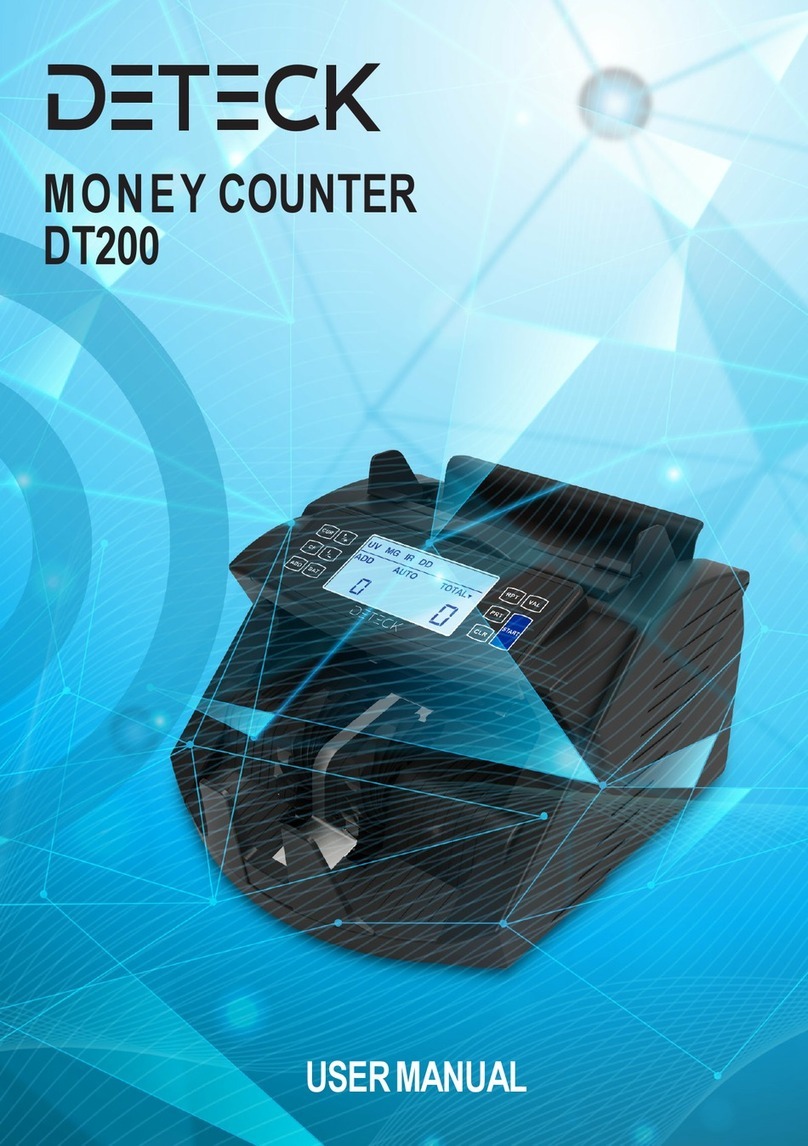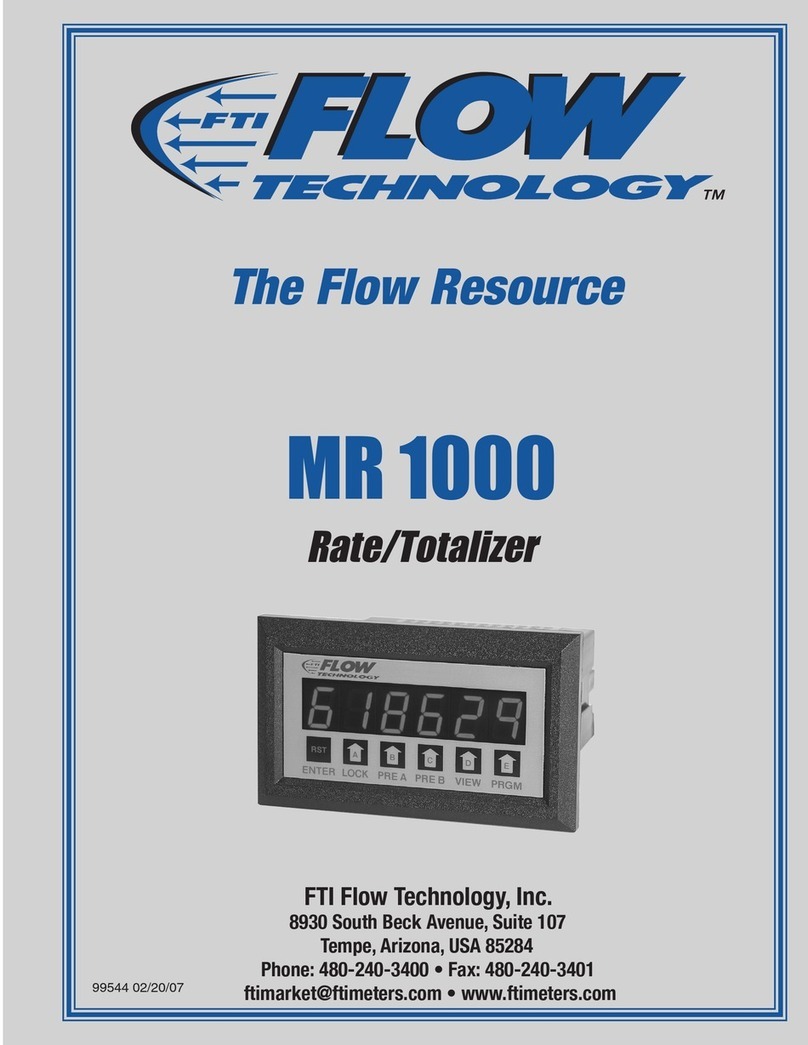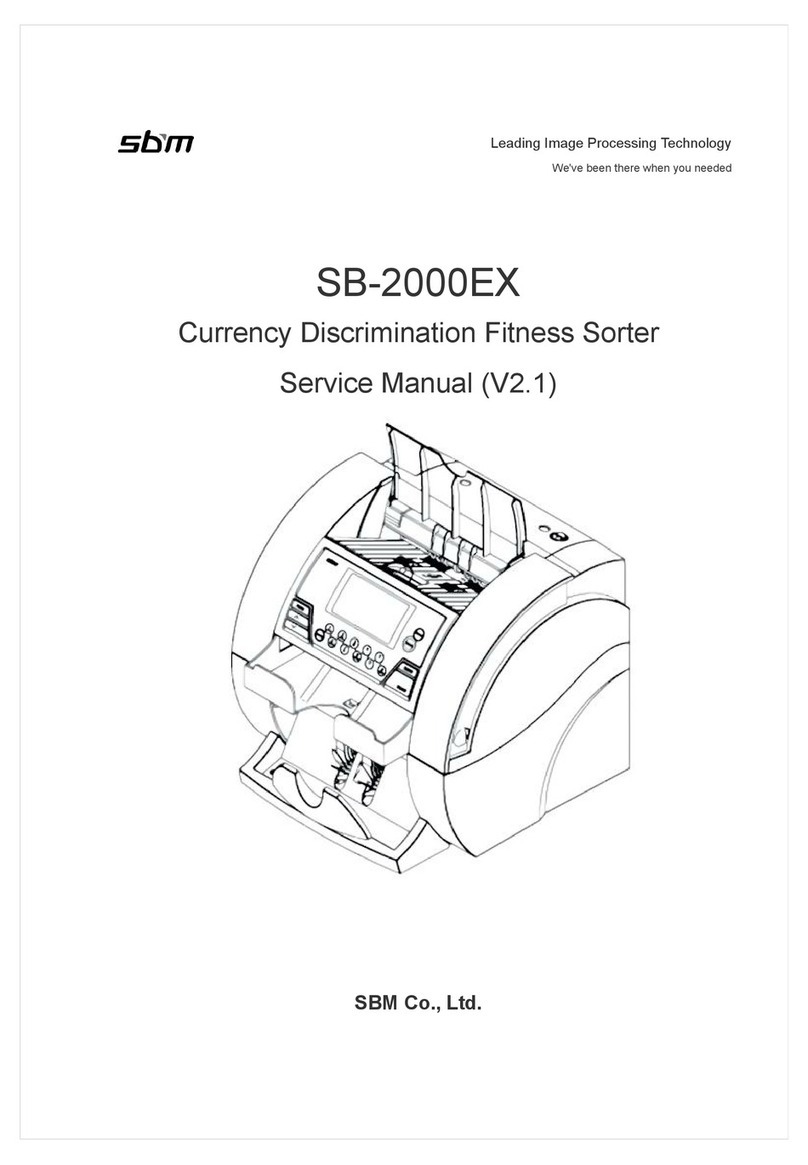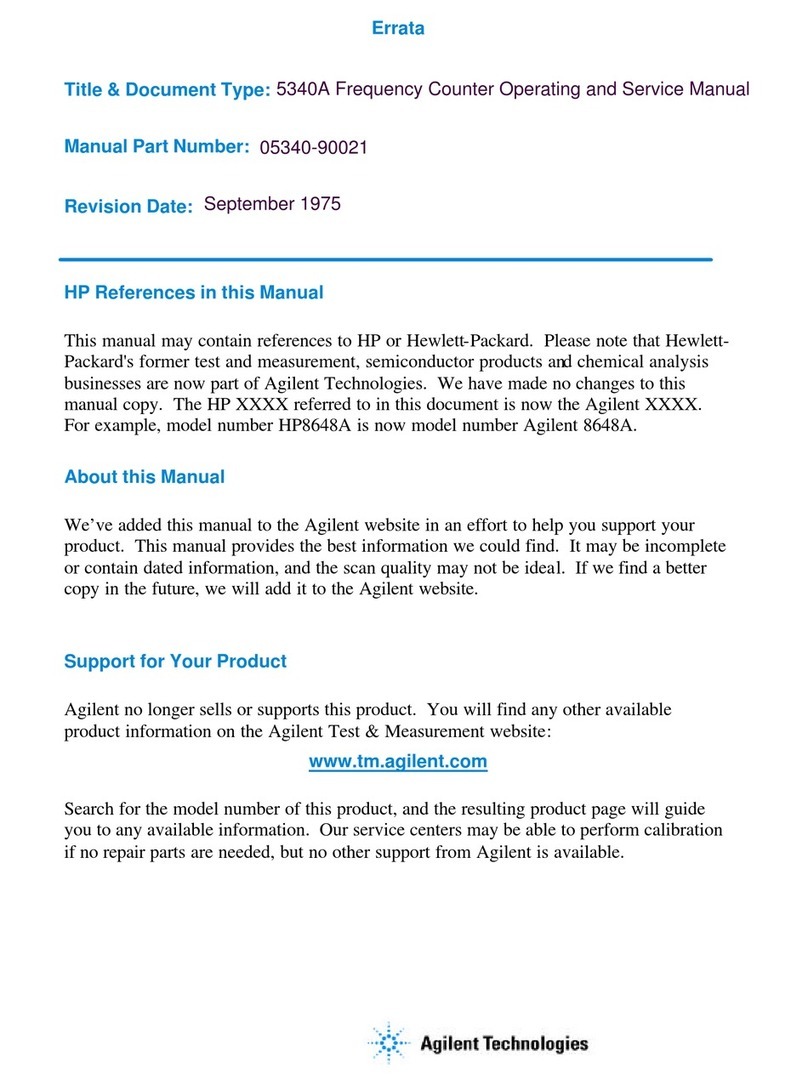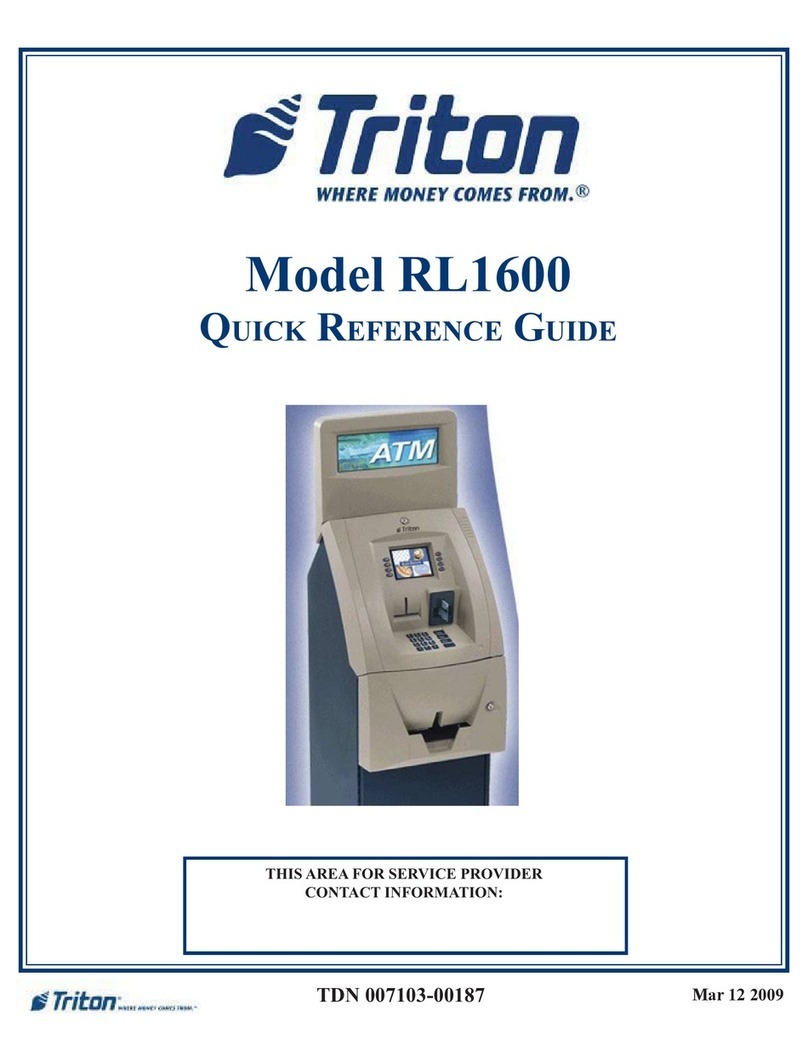DATA PRECISION 5740 User manual

72-1002-C
Instruction
Manual
for
MODEL
5740
MULTIFUNCTION
COUNTER
Specifications
Operation
Theory
of
Operation
Maintenance
Parts
Lists
Schematics
qi
IDATA
PRECISION

72-1002
Model
5740
COUNTER
COPYRIGHT
1975
DATA
PRECISION
CORPORATION
PRINTED
IN
U.S.A.
Second
Edition
-
March
1977
PROPRIETARY
NOTICE
The
information
contained
in
this
publication
is
derived
in
part
from
proprietary
and
patent
data
of
the
Data
Precision Corporation.
This
informa
tion
has
been
prepared
for
the
express
purpose
of
assisting
operating
and
maintenance
personnel
in
the
efficient
use
of
the
Model
5740
Multifunction
Counter,
and
publication
of
this
information
does
not
convey
any
rights
to
reproduce
it
or
to
use
it
for
any
purpose
other
than
in
connection
with
the
installation,
operation,
and
maintenance
of
the
equipment
described
herein.
COPyRIGHT
1975
DATA
PRECISION
CORPORATION
PRINTED
IN
THE
US.A.

72-1002
Model
5740
COUNTER
CONTENTS
1.
INTRODUCTION
1.1
General
1.2
Specifications
2.
OPERATION
S
CALIBRATION
2.1
General
2.2
Controls
£
Indicators
2.3
Measure
Frequency
2.3.1
General
2.3.2
Step-by-Step
Procedure
2.U
Measure
Period
2.4.1
General
2.4.2
Step-by-Step
Procedure
2.5
Totalizing
Events
2.5.1
General
2.5.2
Step-by-Step
Procedure
2.6
Stopwatch
2.6.1
General
2.6.2
Step-by-Step
Procedure
2.7
Ontions
2.7.1
BCD
Outputs
2.7.2
BCD
Interfacing
2.7.3
Remote
STOP/STOP
2.7.4
External
CLOCK
2.8
Calibration
2.8.1
General
2.3.2
Step-by-Step
Procedure
3.
PRINCIPLES
6
THEORY
OF
OPERATION
3.1
General
3.2
Simplified
Block
Diagrams
3.2.1
Measuring
FREQUENCY
3.2.2
Measuring
PERIOD
3.2.3
Counting
Time
Increments
(SECONDS)
3.2.4
Totalizing
EVENTS
3.3
Gating
Controls
3.3.1
Counter
Gate
3.3.2
Divider
Gate
3.4
Counter-Latch-Display
Controls
3.4.1
Intercycle
Control
C
Repetitive)
3.4.2
Manual
Control
3.5
Input
Signal
Conditioning
3
3
3.8
3.9
6
Time
Base
Generation
7
Programmable
Divider
8
Counter
Gating
3.8.1
Counter
Gate
Intercycle
Control
3.9.1
Repetitive
Measurement
3.9.2
Manual
Measurement
10
Counter-Latch-Overflow
11
Display
3.12
BCD
Option
MAINTE5JANCE
4.1
4.2
General
4.1.1
Technician
Qualification
Trouble-Shooting
Strategy
4.2.1
Overall
Flow
Diagram
4.2.2
Display
Symptoms
Test
Equipment
Overall
System
Performance
Check
4.4.1
General
4.4.2
Set-Up
Power
Supply
Check
4.5.1
General
4.5.2
Procedure
Crystal
Time
Base
Check
Counter-Latch-Display
Check
4.7.1
Set-Up
4.7.2
Procedure
Input
Signal
Conditioning,
Pro
grammable
Divider,
and
Decimal
Point
Check
4.8.1
Set-Up
4.8.2
Procedure
5.
PARTS
LISTS
5.1
Display
Assembly
5.2
Main
Assembly
6.
REFERENCE
SCHEMATICS
6.1
Main
PC
Board
6.2
Display
6.3
BCD
Option
4.5
4.6
4.7
4.8
ILLUSTRATIONS
2-1
Model
5740
Front
Panel Controls
and
Indicators
2-2
Model
5740
Rear
Panel
3-1
Model
5740
FREQUENCY
Measurement
Simplified
Block
Diagram
3-2
Model
5740
PERIOD
Measurement
Simplified
Block
Diagram
3-3
Model
5740
SECONDS
Measurement
(STOPWATCH)
Simplified
Block
Diagram
3-4
Model
5740
EVENTS
Totalizing
Simplified
Block
Diagram
3-5
Model
5740
Input
Signal
Conditioning,
Schematic
3-6
Model
5740
Programmable
Divider,
Schematic
3-7
Model
5740
Counter
Gating,
Schematic
3-8
Model
5740
Intercycle
Control,
Schematic
3-9
Model
5740
Intercycle
Control,
Timing
Waveforms
3-10
Model
5740
High
Speed
LSD
Timing
Waveforms
4-1
Overall
Trouble-Shooting
Flow
Diagram
4-2
Power
Supply
Trouble-Shooting
Strategy
and
Test
Sequence
4-3
Model
5740
Main
PC
Board
Assembly
Test
Points
and
Components
4-4
Crystal
Time
Base
Check
Test
Sequence
4-5
Input
Signal
Conditioning
6
Decimal
Point
Test
Sequence
4-0
Input
Signal
Conditioning
£
Attenuator
Test
Check
4-7
Programmable
Divider
Test
Sequence
4-8
Intercycle
Control
Test
Sequence
COPYRIGHT
1975
DATA
PRECISION
CORPORATION.
PRINTED
IN
THE
USA.

72-1002
Model
5740
COUNTER
-6
Frontispiece.
Model
5740
Multifunction
Counter
COPYRIGHT
1975
DATA
PRECISION
CORPORATION
PRINTED
IN
THE
U.S.A.

72-1002
Model
5740
COUNTER
1
INTRODUCTION
1.1
GENERAL
Data
PrecisionModel
5740
Multi-Function
Counter
is
a
medium-frequency,
seven
deci
mal-digit
display
unit,
capable
of
opera
ting
in
any
one
of
four
measurement
modes.
The
Model
5740:
1)
Measures
frequencies
of
repetitive
signals
from
5Hz
to
lOOMHz.
2)
Measures
periods
from
0.5usec
to
0
.
2
sec.
3)
Measures
time
intervals
from
0.01
sec
to
99
,
999.99sec,
and
displays
five
integral
decades
and
two
decimals
of
the
total.
9)
Provides
a
front-panel
trigger
level
control
to
adjust
threshold
of
axis
cross
ings
for
low
duty-cycle,
offset,
and
AM-
modulated
inputs.
10)
Incorporates
a
built-in
hysteresis
so
that
noisy
input
signals
may
be
mea
sured
accurately.
11)
With
BCD
option
installed,
provides
four-line
BCD
(1-2-4-8)
output
data
for
each
of
the
seven
digits,
decimal
point
location,
and
counter
status
signals
for
remote
display,
recording,
or
data
pro
cessing
applications.
Also
includes
re
mote
START-STOP
control
for
Time
measure
ments
.
4)
Totalizes
events
from
one
to
9,999,999
and
displays
seven
full
decades
of
that
total.
5)
Provides
four
selectable
time
in
tervals
from
O.Olsec
to
lOsec
over
which
to
average
the
measured
frequency.
6)
Provides
four
selectable
multiples
from
1
to
1000
of
the
number
of
cycles
over
which
to
average
the
measured
period,
7)
Automatically
positions
the
display
ed
decimal
point
to
obtain
direct
readout
of
kilohertz
(Frequency
measurement),
microseconds
(Period
measurement),
hun-
dredths
of
seconds
(Time
interval
measure
ment),
or
units
(Events
measurement).
8)
Makes
its
measurements
with
signal
inputs
as
low
as
lOmV
RMS
(sine
wave)
or
30mV
peak
(pulse),
with
duty
cycles
as
low
as
10%
of
CW
or
AM
modulated
signals.
12)
Has
optional
provision
for
intro
ducing
high
precision
external
crystal-
controlled
time
base
in
addition
to
the
internal,
aged-crystal
controlled
time
base
circuit.
The
instrument
is
self-contained
in
one
portable
case
only
3-1/2"
high
by
8-1/2"
wide
by
7-1/4"
deep,
with
a
car
rying
handle
that
doubles
as
a
tilt
stand.
A
three-wire
line
power
cord
is
integral
with
the
unit,
and
the
power
line
is
protected
with
a
rear-panel
ac
cessible
line
fuse.
All
operating
con
trols,
indicators,
and
input
connec
tions
are
front-panel
mounted.
Each
instrument
is
designed
for
one
of
the
standard
115
or
230V,
47
to
430
Hz
power
mains,
and
the
particular
source
for
which
the
instrument
is
wired as
it
leaves
the
factory
is
shown
on
the
rear
panel
label.
COPYRIGHT
1976
DATA
PRECISION
CORPORATION.
PRINTED
IN
THE
US.A.
11

72-1002
Model
S740
COUNTER
1.2
SPECIFICATIONS
1.2.1
Mode
Performance
jj
c
o
B
0)
u
3
cn
>1
o
c
<D
0)
U
Ranges:
Sinewave:
Pulse:
Gate
Times/Resolution:
5Hz to
lOOMHz
0
pps
to
100,000,000
pps
(Double
Pulse
Resolution:
15
nanosec.
between
consecutive
pulses)
.01
sec/lOOHz
.1
sec/
lOHz
1
sec/
iHz
10
sec/0.iHz
Accuracy:
±1
count
±
time
base
uncertainty
Readout:
Directly
in
Kilohertz
(7
decimal
digits)
c
(1)
B
C
u
3
W
c
s
•H
<u
0.
Ranges:
Sinewave:
0.5
to
200,000.0
^sec.
(5Hz
to
2MH2)
Pulse:
0.5
to
9,999,999
psec.
(0
pps
to
2,000,000
pps)
(Max.
Resolution:
1
nanosec.)
Periods
Averaged/
Resolution:
Accuracy:
Readout:
1/
1
usec.
10/
0.1
usec.
100/
0.01
usec.
1000/0.001
usec.
Trigger
Uncertainty
('^
20
nanosec.)
No.
of
Periods
Averaged
Directly
in
microseconds.
+
time
base
uncertainty
±1
count
.j
c
c
-H
0)
N
>
W
IB
■P
o
Eh
Ranges:
Signal:
Sinewave:
Pulse:
0
to
9,999,999
to
Overflow
(counting
continued
after
overflow)
5Hz
to
2MHz
0
to
2M
pps
x:
B
p
o
"O
c
P
B
u
g o e
S
u
0)
a
o
El
o
W
3
P
U)
cn
Id
Ranges:
Resolution:
0
to
99,999.99
seconds
(27.78
Hrs.)
0.01
seconds
1-2
COPYRIGHT
1975
DATA
PRECISION
CORPORATION
PRINTED
IN
THE
U.SA.

72-1002
Model
5740
COUNTER
1.2.2
Instrument
Performance
Time
Base
Type:
Frequency:
Uncertainty:
Stability:
Temperature:
Power
Supply
Sensitivity:
Warm-up
Time:
High-Stability
Crystal
lOMHz
±0.1
ppm.
Field
adjustable
±0.01
ppm/sec.
(Jitter)
±0.6
ppm/month
±4.0
ppm/year
±5
ppm,
oven
0°C
to
40°C
<0.1
ppm
at
all
modes
<
10
minutes
to
rated
performance
Input
Characteristics
Coupling:
Impedance:
Sensitivity
(@
xl
Atten):
Trigger
Level:
AC
(RC:i<0.05
seconds)
1
Megohm
||
25pf
(Input
2V
@
xl
Atten)
68
kilohm
(Input
2V
@
xl
Atten)
Sinewave:
lOmV
RMS
5Hz
to
20MHz
linearly
to
50mV
RMS
(?
lOOMHz
Pulse:
30mV
p-p
@
.25
nanosec.
width
linearly
to
150mV
p-p
@
7.5
nanosec.
width
Rise
Time:
for
adequate
sensitivity
after
RC=
0.05
sec.
coupling
Dwell
Time:
>
200
nanosec.
(Period)
5
nsec.
(Freq.
,
Events)
Adjustment
Range
@
xl
Atten
=
±0.5V
@
x20
Atten
=
±10V
Maximum
Inputs
w/o
Damage:
Sinewave:
Pulse:
DC
to
50KHz:
250V
RMS
50KHz
to
lOOMHz:
V
x
F
Product
=
12.5
x
10^
(Or
5V,
whichever
is
the
greater)
Peak
AC
+
DC
500V
(AC
component
limited
as
above)
Display
7
LED
decimal
digits,
0.43"
high
5
LED
decimal
point
2
LED
Annunciators
(Gate,
Overflow)
COPYRIGHT
1975
DATA
PRECISION
CORPORATION.
PRINTED
IN
THE
US.A.
13

72-1002
Model
S740
COUNTER
Power,
Physical,
Environmental
Powers
115V,
50/60Hz,
or
230V
SO/SOHz,
factory
connected;
12
Watts
Dimensions:
aS"
H
x
W
x
7-3/4"
D
(without
handle),
or
89cm
x
216cm
X
185cm
Weight:
6"!
lbs.
(shipping),
5
lbs.
(net);
or
2.27)cg
or
2.951cg,
respectively
o
o
Operating
Temperature:
0
C
to
40
C
Storage
Temperature:
-25°C
to
+75°C
Humidity:
0
to
80%
RH,
non-condensing.
1-4
COPYRIQHT
197B
DATA
PRECISION
CORPORATION
PRINTED
IN
THE
US.A.

72-1002
Model
5740
COUNTER
OPERATION
2.1
GENERAL
Data
Precision
Model
5740
Electronic
Counter
is
operated
using
clearly
marked
front
panel
controls
and
indicators.
Displayed
values
are
read
out
directly
in
engineering
units
of
kilohertz
and
microseconds,
and
annunciator
lamps
in
dicate
counter
OVERFLOW
and
GATE
opera
ting
status.
Remote
display
of
data,
counter
status,
gate
status
and
user
control
signals
(e.g.
printer
enable)
are
available
from
the
rear
panel
connector
when
the
BCD
option
is
factory
installed.
Any
or
all
options
may
be
installed
in
any
one
Counter
configuration.
Power
source
for
the
Model
5740
Counter
may
be
either
of
two
universally
standard
levels,
...
115
or
230,
(47
to
63Hz),
and
each
instrument
is
factory
wired
for
the
nominal
voltage
expected
in
the
area
in
which
the
instrument
is
to
be
shipped.
See
Paragraph
for
instructions
to
modi
fy
the
connections
if
required
for
other
local
conditions.
2.2
CONTROLS
AND
INDICATORS
Figure
2-1
locates
and
identifies
Model
5740
front
panel
controls
and
indicators.
Figure
2-2
locates
and
identifies
Model
5740
rear
panel
features.
Table
2-1
describes
these
controls
and
indicators
and
their
COUNTER
functions.
-
BEFORE
YOU
OPERATE
YOUR
MULTIFUNCTION
COUNTER
-
The
Model
5740
Multifunction
Counter
is
shipped
in
a
pro
tective
fitted
plastic
container.
This
manual
is
packed
in
its
own
wrapper
and
is
placed
outside
the
container.
It
should
be
read
very
carefully
before
operating
the
counter.
Your
shipment
should
contain:
(1)
One
Model
5740
Multifunction
Counter,
with
attached
line
cord
and
power
fuse
(2)
Certificate
of
Conformance
(3)
Warranty
Card
(4)
Authenticated
Factory
Acceptance
Test
Data
Sheet
(5)
One
Instruction
Manual,
containing
information
of
Specifications,
Operating
Instructions,
Theory
of
Operation,
Maintenance,
Parts
Lists,
and
Ref
erence
Schematics.
Inspect
the
packing
case
and
the
instrument
for
any
signs
of
damage
during
shipment;
report
immediately
to
the
car-
rier
if
any
apparent
damage.
COPYRIGHT
1975
DATA
PRECISION
CORPORATION.
PRINTED
IN
THE
US.A.
2-1

72-1002
Model
5740
COUNTER
♦
Ci»ac
5740
/\S
■>s
nitr
V
to
u
>
90i
1
0
1
,
.
(j«OATAy
I
TZZI
Lzr
:y
Fig.
2-1.
Model
5740
Front
Panel
Controls
and
Indicators
Fig.
2-2.
Model
5740
Rear
Panel
2
2
COPYRIGHT
1975
DATA
PRECISION
CORPORATION
PRINTED
IN
THE
U.S.A.

72-1002
Model
5740
COUNTER
Table
2
1
MODEL
5740
OPERATING
CONTROLS
AND
INDICATORS
REF.
NAME/DESIGNATION
DESCRIPTION
g
FUNCTION
1.
INPUT
BNC
Connector.
Connects
input
signal
to
be
measured
2
.
ATTEN
Two-position
slide
switch
attenuator
control.
Inserts
X20
or
XI
attenuation
of
input
signal.
3.
MODE
Two-position
slide
switch.
Selects
2
of
4
modes
of
operation:
FREQUENCY/SEC
ONDS
or
PERIOD/EVENTS
4.
OVERFLOW
Indicator
light
in
MSD
display.
When
ON
indicates
count
greater
than
9,999,999
5.
GATE
Indicator
light
in
display.
When
ON
in
dicates
an
input
is
gated
into
counter.
6.
Display
Seven
decimal
digits
and
four
decimal
point
positions
0.5"
LED
display.
7
.
Automatic-Manual
Counter
Gate
Con
trol
Eight
position
rotary
switch.
Turns
OFF
instrument
(fully
clockwise).
Selects
one
of
four
averaging
intervals
in
auto
matic
modes
(FREQUENCY
or
PERIOD);
es
tablishes
RESET-COUNT-HOLD
sequence
for
manual
measurement
modes.
8
.
TRIGGER
Potentiometer
control
adjusts
Schmidt
Trigger
firing
level
to
permit
measure
ment
of
low
duty
cycle
input
signals.
9
.
Handle
Carrying
handle.
Also
serves
as
tilt
stand
for
bench
operation.
10.
Line
Cord
Attached
3-wire
line
power
cord.
ElA-
type
plug.
11.
Fuse
l/'+-3mp
slow
blow
fuse
in
series
with
primary
power
input.
12
.
P.C.
Board
Connector
Used
in
BCD
option.
2.3
MEASURE
FREQUENCY
2.3.1
General
In
FREQUENCY
mode
of
operation,
the
Model
5740
counts
axis
crossings
of
the
pulse
train
derived
from
the
input
signal
for
a
selected
time
interval
(as
deter
mined
by
the
rotary
knob
setting
of
Gate
Time).
The
decimal
point
is
automatically
positioned
accordingly
so
that
the
display
is
direct
reading
in
kilohertz.
2.3.2
Step-by-Step
Procedure
a)
Operate
MODE
switch
to
the
SEC•FREQ
position.
b)
Operate
the
rotary
switch
to
IS
time
base.
c)
Connect
input
to
BNC
connector.
d)
Operate
ATTEN
switch
to
appropriate
position
for
expected
magnitude
of
input
signal.
(For
inputs
less
than
40V,
oper
ate
ATTEN
to
XI.
)
COPYRIGHT
197S
DATA
PRECISION
CORPORATION.
PRINTED
IN
THE
U.S.A.
2
3

72-1002
Model
5740
COUNTER
e)
Set
TRIGGER
LEVEL
for
stable
values
on
display.
(Start
with
knob
indicator
at
zero,
or
midposition.)
f)
Observe
OVERFLOW
indicator.
If
ON,
operate
rotary
switch
to
select
lower
val
ue
gate
time
of
O.lsec.
If
OVERFLOW
re
mains
ON
when
gate
time
is
O.IS,
then
in
put
signal
is
above
lOOMHz
specification
limit.
If
OVERFLOW
is
OFF,
and
if
greater
resolution
is
desired,
operate
rotary
switch
to
increase
gate
time
to
lOS
posi
tion.
In
this
position,
measurement
will
be
repeated
in
10.3
seconds,
and
least
significant
digit
will
indicate
O.lHz
in
crements
.
g)
Read
display
directly
in
kilohertz
when
value
is
stable.
Table
2-2
summa
rizes
the
operation
of
the
Model
57U0
for
different
control
settings
in
measuring
two
frequency
input
signals.
2.4
MEASURE
PERIOD
2.4.1
General
In
PERIOD
Mode,
the
Model
57it0
counts
time
increments
for
a
number
of
pulses
determined
by
the
axis
crossings
of
the
input
signal
and
as
selected
by
the
op
eration
of
the
front
panel
rotary
switch.
The
decimal
point
is
automatically
po
sitioned
so
that
the
displayed
period
or
average
period
value
may
be
read
direct
ly
in
microseconds.
2.4.2
Step-by-Step
Procedure
a)
Operate
the
MODE
slide
switch
to
PERIOD-EVENTS.
b)
Operate
rotary
switch
to
100
(100
periods
to
be
averaged.)
Table
2-2
MODEL
5740
FREOUENCY
MEASUREMENT
PARAMETERS
Input
GATE
TIME
Settling
Display
Display*
Frequency
Time
Gate
is
open
Resolution
Overflow
MHz
(LSD)
10
sec
.IHz
ON
231+.
5678
1
sec
IHz
OFF
1231+.
567
1.231+5678
.
1
sec
lOHz
OFF
01231+.
56
.01
sec
lOOHz
OFF
001234.5
10
sec
.
IHz
ON
999.9900
99.999990
1
sec
IHz
ON
9999.990
100
msec
lOHz
OFF
99999.99
10
msec
lOOHz
OFF
099999.9
*For
greatest
resolution,
use
Time
Base
setting
for
minimum
number
of
leading
zero's
without
OVERFLOW.
2-4
COPYRIGHT
1975
DATA
PRECISION
CORPORATION
PRINTED
IN
THE
U5.A.

72-1002
Model
5740
COUNTER
Table
2-3
MODEL
5740
PERIOD
MEASUREMENT
PARAMETERS
Input
Period
No.
of
Input
Resolution
Overflow
Micro-
Cycles
Gate
Was
(LSD)
Light
Display*
Seconds
Open
»
123456.GO
1
1
us
OFF
G123456
IG
.
1
us
OFF
123456.G
^8.IHz
IGG
.01
us
ON
23456.00
IGGG
.GGl
us
ON
3456.GOG
^Select
resolution
position
for
non-overflow
reading
with
minimum
leading
zero's.
c)
Connect
input
to
BNC
connector.
d)
Operate
ATTEN
to
appropriate
posi
tion
for
expected
magnitude
of
input
signal.
(For
inputs
less
than
40V,
ATTEN
=
XI.)
e)
Set
TRIGGER
LEVEL
for
stable
val
ues
on
display.
(Start
with
knob
indi
cator
at
zero,
or
midposition.)
f)
Observe
OVERFLOW
indicator.
If
ON,
operate
rotary
switch
to
select
lesser
number,
10,
of
periods
to
be
averaged;
if
OVERFLOW
is
still
ON,
rotate
switch
to
select
least
number,
1,
of
periods
to
be
averaged.
If
still
in
OVERFLOW,
Period
is
greater
than
9
,
999,999usec
(or
10
sec),
and
if
sine
wave,
then
input
is
not
within
specified
value.
g)
Read
display
directly
in
micro
seconds,
when
displayed
value
is
stable.
Table
2-3
summarizes
the
operation
of
Model
5740
for
different
control
set
tings
when
measuring
an
input
period
corresponding
to
approximately
8Hz.
2.5
TOTALIZING
EVENTS
2.5.1
General
In
the
EVENTS
mode
of
operation,
the
Model
5740
counts
axis
crossings
of
the
input
signal
over
a
time
interval
deter
mined
by
the
manual
operation
of
the
front
panel
rotary control
knob
(or
by
electrical
control
signals
when
the
BCD
option
is
installed).
2.5.2
Step-by-Step
Procedure
a)
Operate
MODE
switch
to
PERIOD-
EVENTS
position
b)
Operate
Rotary
switch
to
RESET
position
c)
Connect
input
to
BNC
front-panel
connector
d)
Operate
ATTEN
switch
to
appropriate
position
for
expected
input
amplitude.
(For
inputs
greater
than
40
volts,
op
erate
ATTEN
to
X2G.)
e)
Operate
Rotary
switch
to
SEC-EVENTS
position.
The
GATE
light
comes
ON
and
remains
ON
while
counting
events.
f)
Observe
counted
value
as
displayed.
If
the
displayed
values
appear
to
be
much
more
erratic
than
expected,
then
operate
TRIGGER
LEVEL
control
to
stabi
lize
the
counting.
g)
To
stop
the
counting,
operate
the
Rotary
switch
to
the
HOLD
position.
h)
To
continue
the
counting
from
the
previously
held
value,
operate
the
Rota
ry
switch
to
the
SEC-EVENTS
position.
i)
To
start
a
new
events
totalizing
cycle
begin
with
Step
b)
above.
COPYRIGHT
1975
DATA
PRECISION
CORPORATION.
PRINTED
IN
THE
U.S.A.
26

72-1002
Model
5740
COUNTER
2.6
STOPWATCH
2.6.1
General
In
SECONDS
mode
of
operation,
the
Model
5740
is
used
as
a
STOPWATCH
and
counts
time
in
increments
of
0.01
seconds
for
an
interval
under
manual
control
via
the
front
panel
rotary
switch
or
by
electrical
control
signals
when
the
BCD
option
is
in
stalled.
The
displayed
value
is
read
out
directly
in
seconds
(to
0.01
sec
resolu
tion);
the
decimal
point
is
correctly
po
sitioned
on
the
display.
2.6.2
Step-by-step
Procedure
a)
Operate
MODE
slide
switch
to
SEC'FREQ
position.
b)
Operate
the
rotary
switch
to
RESET.
This
action
resets
the
display
to
00000.00.
GATE
Light
goes
OUT
after
display
is
reset.
c)
To
start
timing,
operate
Rotary
switch
to
SEC'EVENTS.
GATE
light-comes
ON
and
remains
ON,
while
the
least
signifi
cant
digit
increments
at
100
per
second
rate.
d)
To
stop
timing,
operate
rotary
knob
to
HOLD.
GATE
light
goes
OUT
and
display
value
remains
at
last
count.
e)
Read
time
in
seconds.
Maximum
value
is
99,999.99
seconds,
or
27.8
hours,
up
to
appearance
of
OVERFLOW.
It
greater
time
interval
is
to
be
counted,
make
note
of
number
of
counter
display
overflows
and
extend
reading
accordingly.
For
example,
if
there
has
been
one
OVERFLOW,
the
maxi
mum
value
will
be
199,999.99
seconds.
(The
OVERFLOW
annunciator
remains
ON
from
moment
of
first
OVERFLOW.)
f)
To
continue
STOPWATCH
action
from
the
held
count,
operate
Rotary
switch
to
SEC-EVENTS
position.
g)
To
start
new
STOPWATCH
timing
cycle,
operate Rotary
switch
to
RESET
as
in
Step
b)
above.
value,
operational
status,
and
control
circuitry.
Terminal
designations
for
the
44-pin
edge
connector
are
identified
in
Table
2-4.
Note
that
two
signals
are
used
to
identify
the
four
operating
modes,
and
combinations
of
these
two
for
each
operating
mode
are
shown
in
Table
2-5.
2.7.2
BCD
Output
Interfacing
a)
Data
outputs
are
parallel,
BCD
(1,
2,4,8)
and
DTL/TTL
compatible.
Logic
"1"
>
-t-2.4V
Logic
"0"
<
0.4V
sink
for
4mA
Fanout
for
2TTL
loads
b)
Status
as
identified
by
the
termi
nal
nomenclature
is
indicated
by
a
high
level
(Logic
"1").
2.7.3
Remote
START/STOP
When
the
optional
provision
for
Remote
START/STOP
is
installed,
the
user
may
control
the
Counter
action
by
applying
a
DTL/TTL
low
level
or
ground
signal
to
the
designated
rear
panel
connector
terminals
as
identified
in
Table
2-4.
NOTE:
The
remote
control
of
the
Counter
must
be
activated
ONLY
when
the
Counter
is
in
the
SEC/EVENTS
counting
operation.
If
in
FREQ
or
PERIODS
AVGD
Mode,
applying
a
remote
control
signal
will
stop
or
reset
the
counting
in
process.
a)
Select
SEC-EVENTS
operation
at
the
front
panel.
b)
Obtain
the
desired
Counter
perfor
mance
by
applying
digital
logic
levels
in
accordance
with
the
table
below.
Counter
Operation
RESET
HOLD
RESET
"0"
"
1
"
COUNT
"1"
M
2
IT
HOLD
»»2»»
"0"
"0"
=
Ground
or
<'2.5VDC
or
disconnected
"1"
=
3.5V-HVDC
2.7
OPTIONS
2.7.4
Extarnal
CLOCK
2.7.1
BCD
Outputs
When
BCD
option
is
installed,
internal
circuits
are
modified
and
the
main
PC-
board
terminals
are
connected
to
counter
2-6
When
the
optional
provision
for
External
CLOCK
is
installed,
the
Model
5740
rear
panel
is
modified
to
incorporate
a
BNC
connector
and
switch.
To
use
the
external
clock
feature,
an
accurate
oscillator
of
10
MHz
should
be
available.
COPYRIGHT
1975
DATA
PRECISION
CORPORATION
PRINTED
IN
THE
US.A.

72-1002
Model
5740
COUNTER
a)
Connect
the
external
10
MHz
CLOCK
to
the
rear-panel
BNC
connector.
b)
Operate
the
rear
panel
selector
switch
to
EXTERNAL.
NOTE:
The
internal
clock
remains
ins,
.v
lied
in
this
option,
and
the
user
may
switch
to
the
internal
clock
by
operating
the
rear
panel
switch
to
INTERNAL.
2.8
CALIBRATION
2.8.1
General
The
Model
5740
COUNTER
time
base
uti
lizes
a
crystal-controlled
oscillator
whose
frequency
is
adjustable
over
a
very
narrow
range
by
capacitor
C12.
If
a
very
accurate
frequency
standard
is
available
(better
than
.Olppm)
it
may
be
used
to
calibrate
the
Model
5740
COUNT
ER,
using
the
procedure
detailed
in
the
next
paragraph.
2.8.2
Step-by-Step
Procedure
a)
Allow
30
minute
warm-up.
b)
Set
up
the
frequency
standard
for
a
signal
near
full
scale
range
of
the
COUN
TER:
lOMHz
on
IHz
resolution
scale.
Con
nect
to
COUNTER
INPUT,
i.e.,
use
frequency
of
approximately
1,
10,
or
lOOMHz.
c)
Set
up
COUNTER
for
FREQUENCY
Mode,
select
1
sec
gate
time.
dj
Remove
top
cover
of
the
COUNTER;
locate
trim
capacitor
C12
(See
Figure
4-3).
e)
Adjust
C12
until
measured
value
is
equal
to
the
frequency
standard
and
results
in
0000.000
display
plus
overflow
indica
tion.
f)
Remove
standard;
close
cover;
unit
is
recalibrated.
Table
2-4
OPTIONS:
BCD
&
Remote
START/STOP
CONNECTOR
DESIGNATIONS
n
D4B1
'
1
D4B2
'
2
D4B4
[
3
D4B8
4
PRINT
ENABLE
|
5
A
]
D1B4
B
D1B2
C
1
DlBl
D
,
D1B8
E
'
DPI
1
1
D5B1
,
6
D5B2
i
7
D5B4
8
D5B8
'
9
lio
F
'
DP5
H
1
DP4
J
'
DP3
K
1
DP2
L
D2B2
1
1
|11
MODE(I)
12
D6B1
'13
D6B2
|14
D6B4
'l5
1
M
,
D2B1
N
1
P
'
R
1
MODE(I)
S
1
D3B8
D6B8
|16
RESET*
17
D7B1
'18
D7B2
|19
D7B4
20
D7B8
|21
GND
2
2
1
T
'
D3B4
U
'
D2B4
V
'
D2B8
W
1
D3B1
X
D3B2
Y
1
OVERFLOW
Z
'
HOLD*
1
Note
See
Table
2-5
for
Mode
status
decoding.
*Active
only
when
the
Remote
START/STOP
is
installed
Table
2-5
DECODING
MODEL
5740
OPERATING
MODE
SIGNALS
TERMINAL
12
QC
0
1
Z
s
0
FREQUENCY
SECONDS
LU
1
PERIOD
EVENTS
"0"
=
Ground
level;
OV,
nominal
"1"
=
+SV,
nominal
COPYRIGHT
1975
DATA
PRECISION
CORPORATION.
PRINTED
IN
THE
U.S.A.
27

72-1002
Model
5740
COUNTER
CALIBRATION
RECORD
DATE
BY
COMMENTS
DATE
BY
COMMENTS
NOTES
CHANGING
POWER
SOURCE
CONNECTIONS
The
connections
for
power
source
voltage
(lOOV,
115V,
or
23CIV)
are
made
on
the
Terminal
Board
CTBl)
mounted
on
the
inside
of
the
rear
panel,
and
through
which
the
power
source
is
switched
to
the
appropriate
input
transformer
tap.
The
table
below
defines
the
TBl
terminals
to
which
the
lead
from
Switch
1-B
should
be
connected
for
the
designated
power
source.
The
illustration
at
the
right
may
be
used
to
help
identify
the
correct
wire
lead.
POWER
SOURCE
lOOVAC
115VAC
230VAC
CONNECT
Sl-B
to
TBl-S
TBl-4
TBl-3
-MOUNT
L2
TO
S/Dc
re/
TB!
(MOUNT£C>
ON
PjAN£L)
28
COPVRIOHT
1t7B
DATA
PRECISION
CORPORATION
PRINTED
IN
THE
U.S>.

72-1002
Model
5740
COUNTER
3.1
GENERAL
THEORY
and
PRINCIPLES
of
OPERATION
The
Model
5740
MULTIFUNCTION
ELECTRONIC
COUNTER
comprises
a
counter-latching
register-display
chain,
an
input
signal
conditioning
circuit,
a
crystal-controlled
time
base,
programmable
digital
control
circuitry,
and
the
necessary
regulated
and
filtered
power
supplies.
Operation
of
two
front
panel
switches
sets
up
the
instru
ment
for
one
of
four
measuring
modes.
The
5740
:
Measures
FREQUENCY
of
Input
Signal
in
Kilohertz
Measures
PERIOD
of
Input
Signal
in
Microseconds
Counts
Time
in
SECONDS
Totalizes
EVENTS
in
Units
Operation
of
the
instrument
for
each
function
is
explained
with
the
aid
of
sim
plified
block
diagrams
for
each
function.
Complete
schematics
are
reproduced
and
bound
in
the
rear
of
the
book
and
should
be
referenced
when
the
theory
of
operation
of
each
module
of
the
instrument
is
de
scribed
.
3.2
SIMPLIFIED
BLOCK
DIAGRAMS
3.2.1
Measuring
FREQUENCY
As
shown
in
Figure
3-1,
when
slide
switch
S4
is
in
the
SECONDS/FREQUENCY
po
sition,
the
input
signal
is
gated
to
the
Counter-Latch-Display
chain,
and
the
IMHz
time
base
is
gated
to
the
Programmable
Divider.
The
selected
position
of
rotary
switch
S3
sets
up
the
divider
for
a
GATE
TIME
base
of
10msec,
100msec,
Isec,
or
lOsec,
while
simultaneously
positioning
the
decimal
point
in
the
display
to
the
appropriate
decade.
INPUT
SIGNAL
CONDIT
MODE
COUNT
GATE
GATE
Tf
S
F
-4
4
«
^
10
1
1
MHZ
MHZ
MODE
GATE
PROGRAM.
DIVIDER
GATE
TIME
"n
S3
I
SYNCH
START
MEASURE
INTERCYCLE
CONTROL
T
Fig.
3-1.
Model
5740
FREQUENCY
Measurement
Simplified
Block
Diagram
COPYRIGHT
197S
DATA
PRECISION
CORPORATION.
PRINTED
IN
THE
U5.A.
3
1

72-1002
Model
5740
COUNTER
In
operation,
input
signals
of
sine
waves
or
pulse
trains
are
converted
to
a
TTL
compatible
pulse
train
by
the
input
signal
conditioning
circuitry
and
gated
to
the
counter
by
control
signals
from
the
intercycle
control
circuitry.
The
Pro
grammable
Divider
operates
on
the
gated
IMHz
time
base
and
counts
down
according
to
the
selected
GATE
TIME.
At
the
end
of
the
selected
GATE
TIME
interval,
the
Intercycle
Control
Circuit
ry
removes
the
enabling
level
from
the
Counter
Gate,
thereby
stopping
the
count
er.
At
the
same
time,
a
three-step
counter
in
the
Intercycle
Control
gener
ates
control
signals
to:
1)
Transfer
the
value
from
the
Count
er
to
a
Latching
Register
which
automat
ically
updates
the
Display,
2)
Reset
the
Counter
in
preparation
for
the
next
conversion
cycle
and,
3)
Initiate
the
next
conversion
cycle
by
enabling
the
counter
gate.
The
sequence
of
control
actions
is
ac
complished
in
approximately
0.3
sec.
3.2.2
Measuring
PERIOD
As
shown
in
Figure
3-2,
switch
S4
is
moved
to
the
tion,
the
input
signal is
Programmable
Divider
and
base
pulse
train
is
gated
er-Latch-Display.
Rotary
used
to
select
the
number
input
signal
counted
down
when
slide
PERIOD
posi-
gated
to
the
the
IMHz
time
to
the
Count-
switch
S3
is
of
periods
of
before
trans
mitting
a
control
indicator
to
the
Intercycle
Control
circuitry.
The
Counter
Gate
is
enabled
for
a
selected
number
of
input
signal
transitions
(Periods)
under
control
of
the
Inter
cycle
Control
circuit.
As
before,
the
Intercycle
Control
circuitry
steps
the
value
from
the
Counter
to
the
Latch
and
thence
to
the
Display,
and
sequences
the
circuit
through
RESET
and
the
start
of
the
next
measurement
cycle.
The
inter
val
between
such
measurements
is
simi
larly
approximately
0.3
sec.
3.2.3
Counting
Time
Increments
(SECONDS)
As
shown
in
Figure
3-3,
when
slide
switch
84
is
placed
in
SECONDS
opera
tion,
the
IMHz
time
base
signal
is
gated
into
the
Programmable
Divider
which,
in
turn,
is
programmed
to divide
by
10,000,
so
that
a
timing
signal
pulse
train
of
0.01
seconds
interval
is
developed
at
its
output
and
connected
to
the
Counter
Gate.
The
Counter
Gate
is
controlled
by
the
action
of
rotary
switch
S3
which
by
passes
the
Intercycle
Counter
program
ming
control.
At
all
times
the
Counter
output
is
transferred
to
the
Latching
register
and
continuously
updates
the
Display.
The
Divider-to-Counter
Gate
is
enabled
whenever
Switch
S3
is
in
the
SEC/EVENTS
position,
permitting
the
time
increments
to
accumulate.
When
S3
is
placed
in
the
HOLD
position,
the
enable
level
is
removed
from
the
Counter
Gate,
and
the
count
value
remains.
Returning
S3
to
the
SEC/EVENTS
position
restores
the
enable
level
to
the
Counter
Gate
and
the
value
in
the
counter
H
INPUT
MODE
SIGNAL
GATE
CONDIT
10
1
MHZ MHZ
MODE
GATE
COUNT
GATE
PERIODS
AVGD
»
^
1
RESET
71
.
PROGRAM.
INTERCYCLE
DIVIDER
CONTROL
SYNCH
START
MEASURF
Fig.
3-2.
Model
5740
PERIOD
Measurement
Simplified
Block
Diagram
3-2
COPYRIGHT
1975
DATA
PRECISION
CORPORATION
PRINTED
IN
THE
US.A.

72-1002
Model
5740
COUNTER
INPUT
SIGNAL
CONOIT
MODE
GATE
T
COUNT
GATE
S-F
-♦
4
10
1
MHZ
MHZ
MODE
GATE
S3
RESET
\/j~-
SEC/EVENTS
HOLD
PROGRAM.
DIVIDER
INTERCYCLE
CONTROL
Fig.
3-3.
Model
5740
SECONDS
Measurement
(STOPWATCH)
Simplified
Block
Diagram
INPUT
SIGNAL
CONDIT
h
MODE
GATE
10
h
MHZ
MHZ
^
r
MODE
I
^
GATE
I
COUNT
GATE
GATE
I
1
RESET
SEC/EVENTS
HOLD
PROGRAM.
DIVIDER
I
r
INTERCYCLE
CONTROL
r
I
I
I
i
l
J
l
Fig.
3-4.
Model
5740
EVENTS
Totalizing
Simplified
Block
Diagram
increases
at
the
100/sec
rate
from
its
previous
value.
Or
the
value
can
be
re
set
to
zero
at
any
time
by
positioning
the
Rotary
Switch
to
RESET
position.
3.2.4
Totalizing
EVENTS
As
shown
in
Figure
3-4,
when
slide
switch
S4
is
placed
in
the
SECONDS/EVENTS
position
and
rotary
switch
S3
is
in
any
of
the
three
manual
positions,
the
input
pulse
train
of
events
is
gated
to
the
Pro
grammable
Divider,
which,
in
turn,
is
set
up
to
divide
by
1,
thereby
providing
a
pulse
output
for
every
event
pulse
input.
As
in
STOPWATCH
Operation,
the
COUNTER
output
is
continuously
transferred
by
the
latching
register
and
thence
to
the
Dis
play.
The
rotary
switch
is
operated
manually
in
the
same
way
as
in
the
SECONDS
Mode,
enabling
the
Counter
Gate
when
in
the
SEC/
EVENTS
position,
holding
the
total
count
when
in
HOLD,
resuming
the
totalizing
count
when
returned
to
the
SEC/EVENTS
po
sition,
and
resetting
to
zero
at
the
RESET
position.
3.3
GATING
CONTROLS
As
described
in
the
previous
paragraphs,
the
functions
of
the
Model
5740
instrument
are
accomplished
by
internally
programming
the
Counter
and
Divider
according
to
the
function
selected
by
the
combined
settings
of
slide
switch
S4
and
rotary
switch
S3.
COPYRIGHT
1975
DATA
PRECISiON
CORPORATION.
PRINTED
IN
THE
U.S.A.
33

72-1002
Model
5740
COUNTER
A
summary
of
the
front
panel
control
ma
trix
is
shown
in
Table
3-1
below.
3.3.1
Counter
Gate
The
Counter
Gate
is
programmed
to
select
one
of
three
inputs:
Conditioned
Input
(FREQUENCY
MODE)
IMHz
Time
Base
(PERIOD
MODE)
Divider
Output
(.01
sec
increments
in
(SECONDS
MODE)
and
in
(EVENTS
MODE)
3.3.2
Divider
Gate
The
Programmable
Divider
Gate
selects
one
of
two
inputs:
Conditioned
Input
(PERIOD,
EVENTS
MODES)
IMHz
Time
Base
(FREQUENCY,
SECONDS
MODES)
3.4
COUNTER-LATCH-DISPLAY
CONTROLS
Operation
of
the
decimal
point
in
the
seven-digit
display
is
also
programmed
according
to
the
function
selected
by
the
combined
settings
of
slide
switch
SU
and
rotary
switch
S3.
A
summary
of
these
control
requirements
is
also
in
Table
3-1.
3.4.1
Intercycle
Control
(Repetitive
Modes)
When
measuring
FREQUENCY
of
a
repeti
tive
input,
or
the
PERIOD
of
one
cycle
of
such
an
input,
the
Counter-Latch-
Display
sequence
is
programmed
by
the
Intercycle
Control
timer.
At
the
end
of
the
switch-selected
time
base
(FREQUEN
CY)
or
switch-selected
number
of
periods
(PERIOD),
counter
control
is
transferred
to
the
Intercycle
Control
circuitry
which
*
Removes
the
input
to
the
counter
*
Transfers
the
counter
value
to
the
latching
register,
and
thence
to
the
display
*
Resets
the
counter
to
zero
3.4.2
Manual
Control
When
counting
SECONDS,
or
totalizing
EVENTS,
the
Counter-Latch
Display
is
pro
grammed
by
the
RESET-SEC/EVENTS-HOLD
posi
tion
of
rotary
switch
S3.
The
RESET
posi
tion
:
*
Removes
the
input
to
the
counter
*
Resets
the
counter
value
to
zero
When
operated
to
the
SEC/EVENTS
position,
the
control
signals:
*
Enable
the
COUNTER
Gate
*
Enable
the
transfer
from
Counter
to
Latch
to
Display
Table
3-1
MODEL
5740
COUNTER
GATING
CONTROL
MEASURING
FUNCTION
Input
To
Counter
Gate
Input
To
Divider
Gate
Divider
Ratio
Decimal
Point
Selection
FREQUENCY
Conditioned
Input
IMHz
Time
Base
Selected
GATE
TIME
Per
Selection
PERIOD
IMHz
Time
Base
Conditioned
Input
Selected
Numbe:"
of
PRDS
AVGD
SECONDS
Divider
Output
IMHz
Time
Base
+
104
=0.01
sec
Interval
DP
3
EVENTS
Divider
Output
Conditioned
Input
+
1
None
3-4
COPYRIGHT
197S
DATA
PRECISION
CORPORATION
PRINTED
IN
THE
U.S.A.

